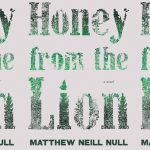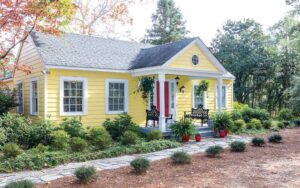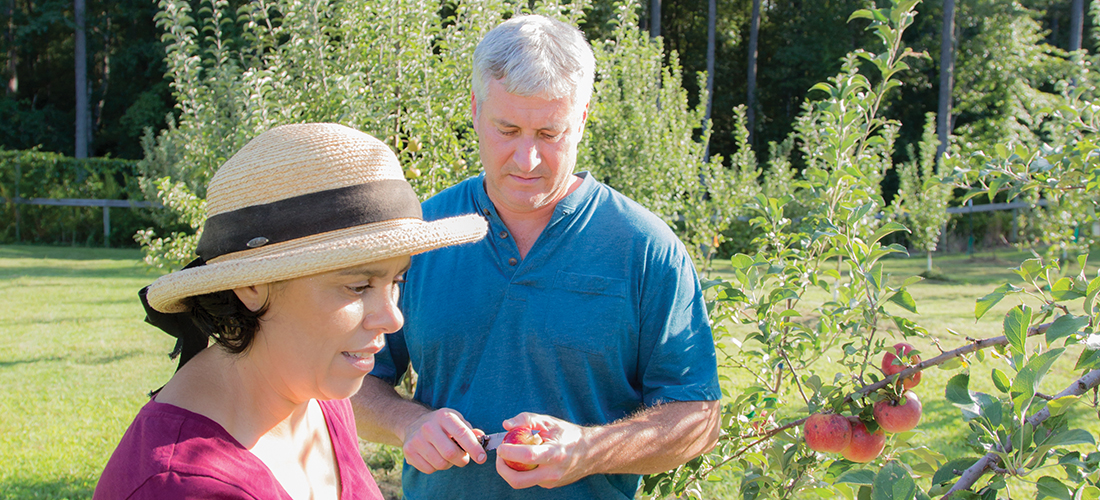
How David and Ann Marie Thornton transformed an empty ice cream stand into a business with a fringe benefit
By Jim Moriarty • Photographs by Laura Gingerich
If you’re going to grow a business from the ground up, you might as well get a good buzz out of it. When Dr. David Thornton and his wife, Ann Marie, turned some of the same varieties of Southern heirloom apples George Washington and Thomas Jefferson had at Mount Vernon and Monticello into hard ciders of their own creation, the experiment blossomed into a cottage industry that could make your head whirl like Auntie Em’s house.
Crates of ripe Grimes Goldens, a fruit with roots dating back to 1790 and Johnny Appleseed, sit under the open-air shelter beside the cider house that, in a previous life, had been the Ferguson farm produce and ice cream stand on Old U.S. 1. The Thorntons’ F350 Super Duty truck is parked nearby, the door wide open so they can hear Nickel Creek on the sound system. Assisted by Erin Knight, who studied agriculture at the University of Vermont, they slice the apples by hand, carving out the bad spots. They dip them in a tub filled with water and a soupçon of bleach to discourage any natural yeasts, then rinse them off with a hose and feed them rapid fire down the metal throat of a crusher as if they were tossing rocks into a wishing well. Cut. Dip. Rinse. Grind. Repeat. The bluegrass mandolin is drowned out by the heavy metal symphony of grinding. Tiny shards of apple fly about like sweet, sticky shrapnel as a 5-gallon bucket fills with mashed pulp. They pour bucket after bucket into a cylindrical silver hydraulic press that, like a vertical colander, squeezes out the juice.
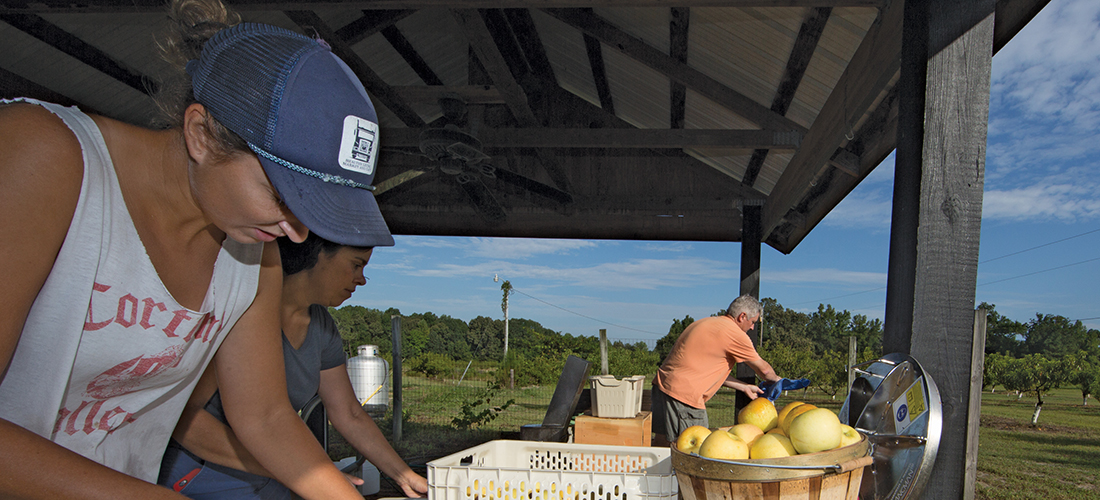
“This will be at least a two shirt-crushing,” says Dave. The old ice cream stand, now a constant 60 degrees, is the lab where they test pH, measure sulfites and add the yeast of their choice, maybe English cider or white wine. “Dave is in charge of microbial control,” says Ann Marie of their “picobrewery,” as she laughingly calls it. The pasteurizing is done in a tank behind the building. The old produce stand fronting the orchards the Thorntons now own is where they put the labels on the bottles with a hand crank machine, 10 in a minute, 1,200 on a weekend on the way to bottling a couple thousand gallons for the season. “I really am the chief cook and bottle washer,” says Ann Marie.
It’s the first season the Thorntons have been able to sell their cider commercially. Previously, they stayed under the legal limit and confined themselves to lighting up local happenings like Stoneybrook or the foxhunt and hanging out a shingle or two at the odd farmers market. Now, they’ll be producing two brands of hard cider, James Creek Cider House, made strictly from their own apples, and Stargazer, which will be a more adventurous version of the hard ciders familiar to most consumers’ taste buds.
“Our James Creek will be a very wine-like cider, refined, dry and relatively higher in alcohol content, about 8 or 8 1/2 percent,” says Ann Marie. “Stargazer is a little bit more on the craft beer, inventive side.” It’s where the Thorntons can get their freak on, blending in a hint of peach, blackberry, ginger, pretty much whatever they feel like. “For Stargazer we press our apples, we press apples from other growers, and we also bought juice. The Stargazer is themed with constellations. Prowling Peach is Leo. He’s a summer constellation. A lot of great apples ripen in October when Orion is high in the sky, so it will be Orion the Mighty Hunter. We might do a blend with persimmon for winter. Stinger for Scorpio. Something like that. I think we’ll have blueberry in the spring.”
Two of their ciders have won prizes in the Great Lakes International Cider and Perry Competition. (Yes, there are cider conventions.) Last year they attended CiderCON in Portland, Oregon. “Physician conferences look pretty bleak compared to cider conferences,” says Dave. “I used to think doctors partied. These guys are having fun.”
The Thorntons aren’t trying to become the Angry Orchard of the East. “If we come out with a good quality product that gets people engaged and just keep it local, then we will have met our goals,” says Dave. “We love this land. We love the countryside. Having something we can use the land for and creating something new is part of the challenge.”
So, how did an intensive care unit doctor and his wife with a master’s degree in English wind up as the Moëts of Sandhills cider?
Dave Thornton grew up in Cincinnati in the Ohio River Valley, where his family was in the produce business, the Castellini Co., still headquartered in Wilder, Kentucky. “The produce warehouses were all down on the waterfront,” he says. “So, I grew up down on the river carrying boxes around and driving forklifts full of fruits and receiving them on the docks. I was surrounded by fruits and vegetables when I was a kid, but I really wanted the farm side.”
Ann Marie grew up in Pelham, New York, a New York City suburb, and the pair met at the University of Notre Dame. They spent a semester in London in the fall of their junior year, simultaneously cultivating one another and a taste for hard cider. After Notre Dame, the Air Force put Dave through medical school. He was on active duty during the 9/11 terrorist attacks. “I used to teach medicine at the Air Force’s residency hospital in San Antonio, but I also worked with Air Force Special Operations Command and ran a team that did light combat search and rescue, took care of the operators if they had problems,” he says. He was in the first task force to Afghanistan. “I wasn’t kicking down doors. The minute somebody found out I was a physician, my street cred went way down.”
San Antonio eventually led the Thorntons and their two daughters, Katheryn and Maura, to Southern Pines, where they found a house and some land bordering James Creek on the outer environs of Horse Country. There was a small, hidden glade, invisible from the house. “We called it a secret field. We thought, well, this would be a lovely place to put some apple trees,” says Dave, who wanted to plant something he could ferment, a boyhood enthusiasm. When he was growing up, he actually had a still in the basement. “I took a still to the university science fair when I was in grade school,” he says, and took a blue ribbon back to the basement. “It was pure science, with a fringe benefit.”
They began reading up on Southern heirloom apples. “Everyone was teasing us. This is peach country. You’re planting apples?” says Ann Marie. “We said, well, it seems like they grew on people’s farms a hundred years ago.”
They did soil preparation in ’08 and began planting trees the next year. “Apple trees are all traditionally done by grafting, so you take a branch cutting from an existing tree and you place it onto a rootstock,” says Ann Marie. The rootstock determines the size of the tree and how soon it produces. The grafting is the genetic material that determines the type of fruit. Sounds simple enough, except for a few things. They weren’t farmers. They weren’t growers. They weren’t pruners or pickers. They weren’t cider makers. They weren’t bottlers. They weren’t marketers. It’s a good thing they each possess a finely tuned sense of humor because the learning curve they were staring at was hysterical.
“They’re highly intelligent people, they really are,” says Taylor Williams, the Agricultural Extension Agent at Moore County’s N.C. Cooperative Extension. “They didn’t grow up in this area. The soils and climate here are quite unique. Ann Marie went through our Farm School Program, where you can sit down and look at the numbers for a business plan related to a farm. Here’s your production costs. Here are your marketing costs. Here’s your likely market. This is what you’re going to have to do to access that. Let me put it this way, for me to take a tobacco farmer who knows all about handling soil and handling the crop and get him geared up toward growing complicated produce crops, that’s a big transition. The Thorntons have had to learn all of that plus some of the soil and fertility managements, then carrying it through to adding value — processing the apples into cider. At every stage there’s a learning curve, plus a regulatory curve, figuring out how to negotiate with the alcohol and beverage control people. Just everything to get a saleable crop and do it legally.” Which is why Ann Marie now has a 60-hour-a-week job.
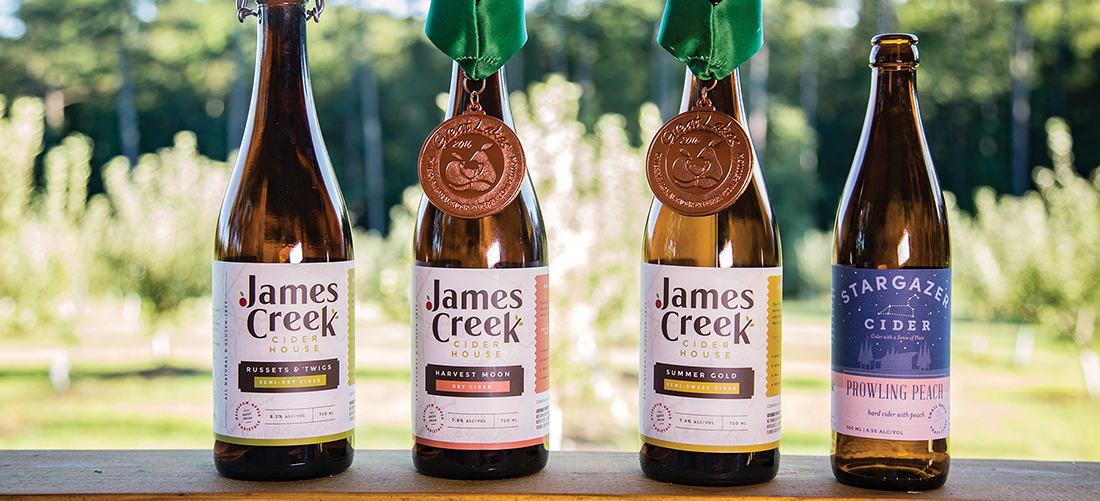
The Thorntons’ research began with Old Southern Apples, a book by Creighton Lee Calhoun Jr., a Pittsboro native described as the man who built the Noah’s ark of Southern heirloom apples. He criss-crossed the South taking cuttings of apple tree varieties to, in many cases, keep them in existence. Calhoun’s banner, to a considerable degree, has been passed to David C. Vernon, an advance placement chemistry and physics teacher at Western Alamance High School, who grows roughly 500 different varieties of mostly Southern heirloom apple trees on his farm, Century Farm Orchards, where the Thorntons bought their first trees.
Along with advice from Williams, the Thorntons got input from Dr. David Ritchie and Dr. Mike Parker from N.C. State University, the former a plant pathologist and the latter a horticulturalist who advised them on plant spacing and pruning. “It’s amazing what a resource we have in those folks,” says Dave. “One of them will come out and I’ll say, ‘Hey, what’s going on with my tree?’ He’ll pick some grass and say, ‘Oh, yeah, you don’t have enough of this.’ I’m looking at the tree. He’s looking at the grass. He knows what’s going on before he even looks at the tree. It’s been a fairly humbling experience.”
The secret field morphed into the Thorntons’ genesis orchard that now has more than 60 heirloom varieties among its 600 or so trees. “Those down there are American Golden Russets,” says Dave as he walks between the rows of their “test” orchard. “This tree is from the 1600s. It’s a Roxbury Russet. It was in Monticello and Mount Vernon.”
“This is a Hewes Crab,” says Ann Marie. “Jefferson said it was his favorite apple. That yellow apple is a Grimes Golden.”
“This is an old Southern apple called a King David,” says Dave. “It was such a heavy crop this year we had to hold the branches up or they’d break right off the tree.” Arkansas Blacks. Johnson Keeper. Summer Bananas. Terry Winter. Limbertwig. “The two of us can get our geek on over this, in no uncertain terms,” says Dave.
In addition to their cider business, Ann Marie takes fruit to the Carrboro Farmers Market, where she’s been doing an “heirloom of the week.” It’s a Peter and Paul dynamic. To ferment or not to ferment, that is the question. “I usually say those apples are for cider,” says Dave. “But the truth is, where cash flow is concerned, Ann Marie wins.”
On her latest trip to Carrboro, a French couple sampled one of the Thorntons’ ciders. “A woman from Normandy told her husband, in French, it tasted like her grandmother’s cider,” says Ann Marie with a smile.
“Right now we’re having a blast,” says Dave. “Fermenting these in groups either by harvest date or by variety and then making hard cider out of them and tasting what each different variety is like. Then what we can do is blend them together to make something that’s very interesting and palatable. The blending at the cider house is pretty cool.”
So are the days in the field. “We keep some German shepherds and they’ll come out on the hillside with us and hang out while we prune away on the trees. You can get a real Zen going about it. The time can just fly by,” he says.
“We recognize the apples from this place may taste differently than they do somewhere else,” says Ann Marie. “That’s OK. We just want to know what they taste like here. What kind of cider can you make here?” It’s a traditional Southern cider to complement traditional Southern foods, fried chicken, barbecue, oysters. Just a couple of Golden Domers at home with their Grimes Goldens. PS
Jim Moriarty is Senior Editor of PineStraw and can be reached at jjmpinestraw@gmail.com.


